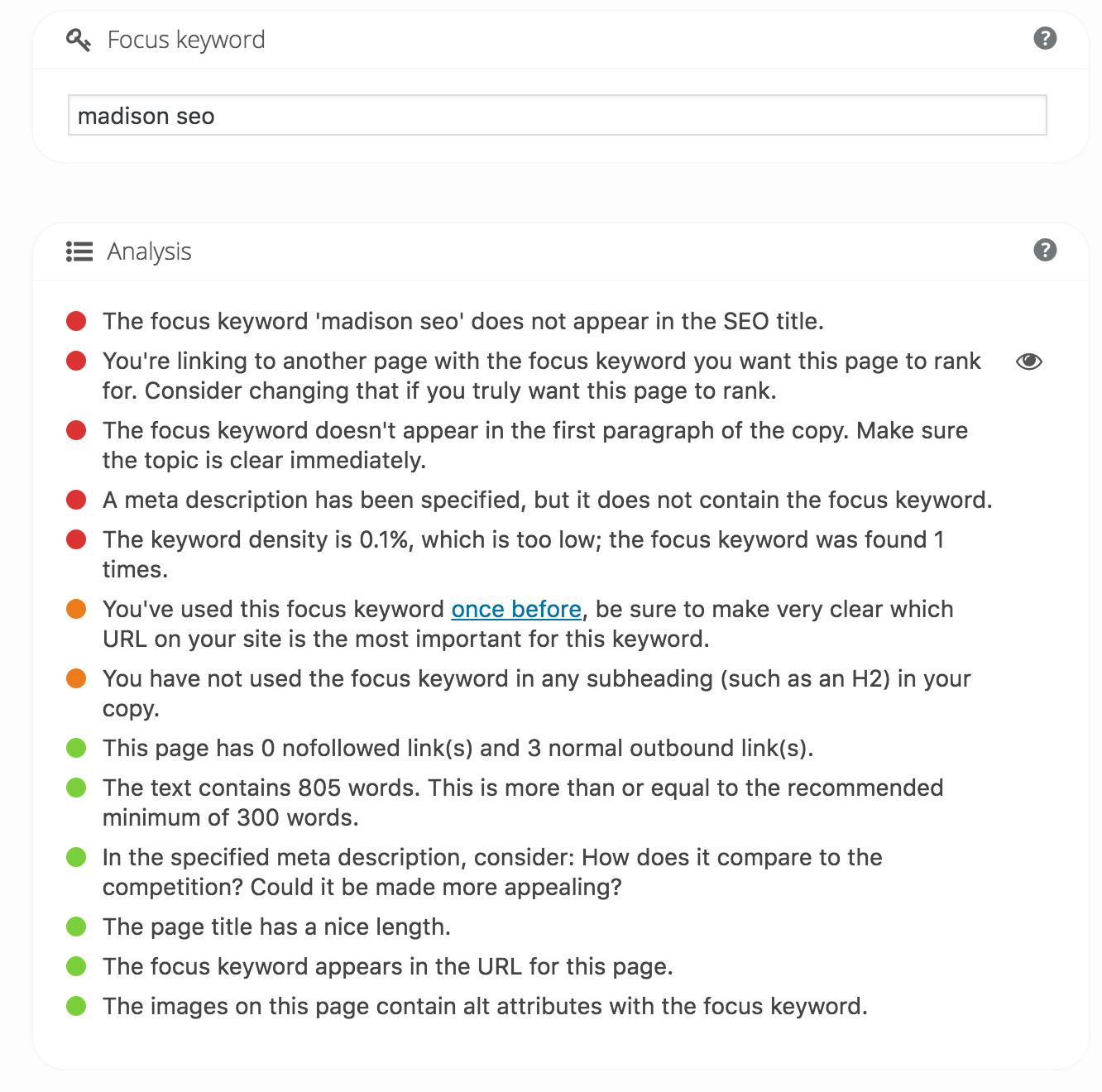Onsite optimization makes a big difference to your SEO because search engines crawl your site and glean keyword information directly from it. Keyword research is step 1 in a local SEO campaign, and onsite optimization is step 2.
Once you know what keywords to target, you can evaluate your website to see if they are included in strategic places in your website’s HTML.
Sometimes this means re-vamping your existing web pages and sometimes this means changing your website structure by creating new pages on your site to target specific keywords.
Your website is one of the few places on the web where you have absolute control over your content online, so we want to take advantage on your home turf!
Optimizing your website structure
Do you have a page for every service you offer? If not, you should create one right away! Google thinks in URLs, so you should, too.
If you just have one or two service pages with all your offerings listed out down the page, Google won’t get the message that the page is about “leg waxing,” or whatever service you’re offering. Plus, when you have a distinct page for each offering, you unlock all of the tags described below as more places to include your target keyword phrase and its synonyms.
Take the ecommerce business Splendid Beast, for example, which sells handmade oil painting pet portraits. After pulling the monthly keyword search data (as described in our keyword research post linked above), we mapped the top-searched terms to pages on the site. We also created new ones where appropriate and identified other keyword targeting opportunities for later, whether in blog posts or standing pages.
Before doing this, the site didn’t even have dedicated pages targeting dog paintings or cat paintings. Nor did the founder of the business think to create a page just for specific breeds, like “french bulldog painting.” That’s why keyword research comes first, and website optimization comes second.
Have multiple locations? We recommend creating a landing page for each location and linking the Google My Business property to each respective location page.
Once you have your site structure in order, it’s time to turn to the individual pages, any of which could appear in Google or Bing’s search results. The following are the major places we want to be sure to include our keywords (and their synonyms).
Title tags
These are the titles for each of your pages. Titles appear in internet browser tabs…
….as well as on search engine result pages (or SERPs).
Each page has a title tag and each page can rank in a search engine, not just your home page. This is often the first part of your site new visitors will see, so make these tags count!
For title tags, we want:
- our best keywords at the beginning
- the titles to be under 60 characters in length so they show fully on result pages
- to include our target city or region right in the title
- to create entirely new pages where appropriate. This could include one for each service or location of yours.
Meta descriptions
While these don’t help directly with SEO, they can help indirectly by telling users who see your link in a search engine result page what they can expect to see if they enter your site.
Include keywords and good descriptions of your business in meta descriptions deliberately, or Google will just grab the first sentence from the body text to put here.
Shoot for 150-160 characters.
h1 and other header (h2, h3) tags
Google and Bing know these are important clues to what each page is about, so be sure to include target keywords in your headers to signal to them that these are important words on your site.
URLs
The ship has likely sailed on naming your domain, but the subdomains and URLs you have on other pages and blog posts can be another place to insert keywords, especially if you’re creating new pages anyway.
The first paragraph of body text on each page
Google seems to weigh the opening content more heavily than the rest of the page, so start talking about your offerings sooner.
Image names and alt text
This is the text that describes image content to search engines. See the pattern here? Say what the picture is but be sure to include keywords, too.
Bonus points for renaming your image files (with keywords) and re-uploading them to your website. At one point, hyphens were better than underscores, which were better than spaces. Here’s an example of an optimized image:
- Filename: online-marketing-team-madison-wi
- alt attribute: Our Wisconsin internet marketing team
Quadruple bonus points for geo-tagging your images so search engines know exactly where the pictures take place. (UPDATE: not sure the best software to use for this anymore as Google acquired Picasa and rolled it into Google Photos.)
Internal link anchor text to your other pages
Your website pages should link to each other for multiple reasons:
- You want visitors to spend time on your site and see your different pages to learn more. For example, click here to learn more about external link building for SEO.
- Google rewards higher visitor engagement like this. You want people to stay on your site longer and visit multiple pages.
- Links allow you more places to target keywords you discovered in your keyword research
So write your copy naturally for human readers, but strategically jump your visitors to your other pages with keyword-rich hyperlinks.
Tools to assist with your onsite SEO
We pay a monthly fee to use Moz Pro, which can provide grades for each page for a target keyword phrase. Moz provides a list of suggestions to improve a page’s onsite optimization. Check out the free month-long trial if you’re interested.
For a free solution you can use long-term, check out the Yoast WordPress Plug-in. This plug-in gives you an on-page grade for the major onsite factors. You can shoot to turn as many of the lights green, but good luck getting all of them (better to call it good enough at a certain point).
Note how one of Yoast’s onpage factors is page text-length. We certainly encourage our clients to be verbose on each of their pages and it pays. When companies pay a company to create a website, no one is generally too gung-ho about writing over 300 words per page. Yet that upfront work generally pays dividends.
Don’t forget to optimize for conversion while you’re at it
Search Engine Optimization (SEO) brings visitors to your site, and because it’s such hard work you want to be certain those visitors take the actions you want them to take once they arrive. That’s why you MUST have clear “calls to action” on each page. Don’t leave any ambiguity as to what the person is supposed to do on the page–give them a nice big button to push!
The action can be to sign up for the email list, go to the contact page, or click to call. Just make sure both you and your website visitors know exactly what they should do on the page.
Remember: your website isn’t a brochure, it’s a sales machine that doesn’t sleep.
What does onsite optimization do?
It can skyrocket your rankings in a few month’s time. We know because we see it happen with each of our clients, including our own rankings. When you include keywords (and synonyms) that people are actually searching for throughout your site, Google and Bing take notice, because now their algorithms “know” what your site is about. In Madison, Wisconsin, SEO right on your website gives you a real edge because so few of your competitors are even bothering with this basic step. Imagine what you can do if you continue through the other phases of your search engine optimization campaign.









